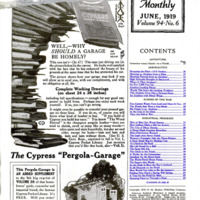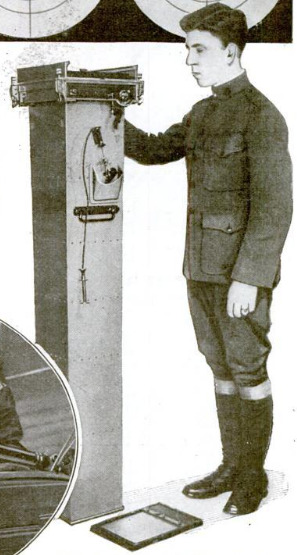Taking pictures from an airplane
Item
-
Title (Dublin Core)
-
Taking pictures from an airplane
-
Article Title and/or Image Caption (Dublin Core)
-
Shooting Pictures from an Airplane
-
extracted text (Extract Text)
-
KNOW what the enemy is doin!
That maxim of warfare demanded
superior airplanes and cameras —air-
planes for sceing and cameras for
recording the things seen. Forthwith
the airplanes were improved on, and so
were the cameras, until now the United
States has a camera that will take
moving pictures of the ground below
from a height of three miles, bringing
out the smallest details—even foot-
prints on the ground. As the sharp
lens of the camera looks through the
bottom of the airplane's fuselage, it
sees things that the airman himself
cannot detect.
‘The lens represents the work of
the Kodak Laboratory and is far
superior to Germany's best. It /
has a focal length of fifty inches |
and a diameter of ten inches.
‘The camera itself is of enormous ke
size, and has two striking new
features—a pan-chromatie plate
which records many different
color values, and a ray filter which
enables the lens to penetrate even
through clouds. Since the end of
the war these cameras have been
used for surveying.
In one instance a map was made
in two and one half hours which
would have taken a hundred survey-
ors five years to finish.
Air fighting came as
an attempt to prevent
enemy observers from
taking these secret-
revealing pictures.
It was very hard to
train the fighters on
land to aim accurately
at the enemy airplanes
which they would meet,
when. flying at. many
angles. This difficulty
was overcome by an-
other American camera
invention.
The gun-camera used
by the British was a
separate unit on the
British airplane. The
‘Americans changed this
gun so that it would fit
the regular Lewis ma-
chine-gunand shoot one
hundred pictures at a
loading. Thus, by shooting pictures '
at each other just as they would shoot
bullets at the enemy, they learned to
correct their aim.
In peace times the gun-camera will
prove valuable in improving airplane
tactics. Every flying-field of the
American army and navy is now
equipped with the device.
-
Language (Dublin Core)
-
eng
-
Date Issued (Dublin Core)
-
1919-06
-
pages (Bibliographic Ontology)
-
35
-
Rights (Dublin Core)
-
Public domain (Google digitized)
-
Archived by (Dublin Core)
-
Davide Donà
-
Marco Bortolami (editor)
 Popular Science Monthly, v. 94, n. 6, 1919
Popular Science Monthly, v. 94, n. 6, 1919






